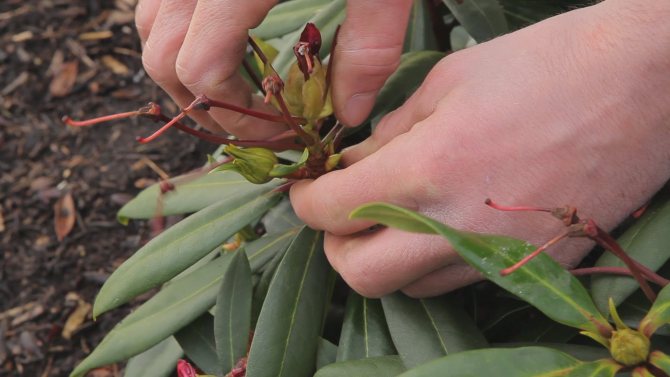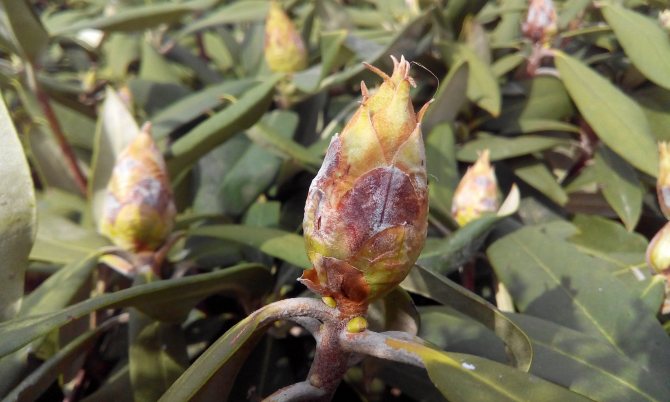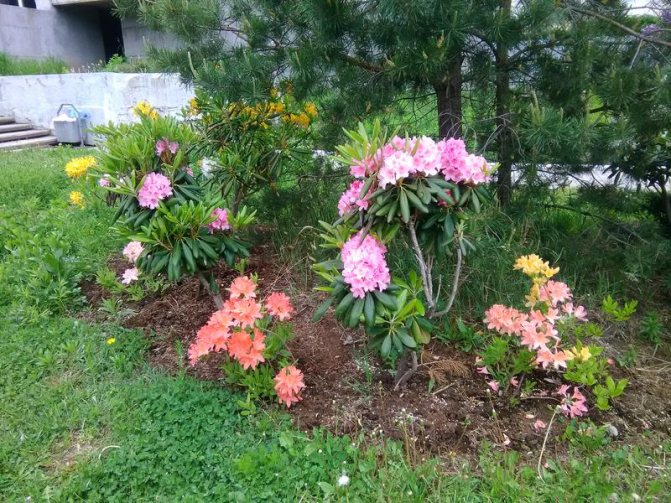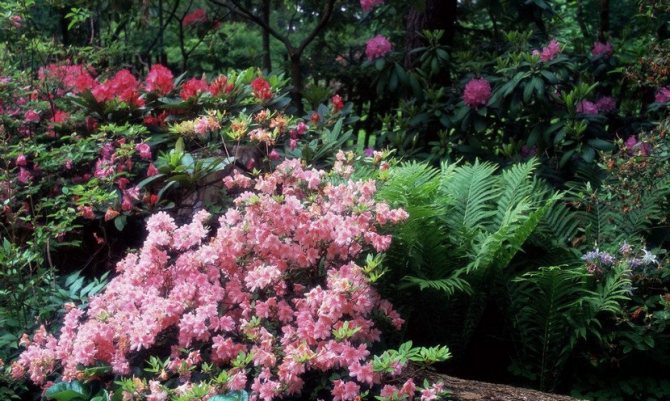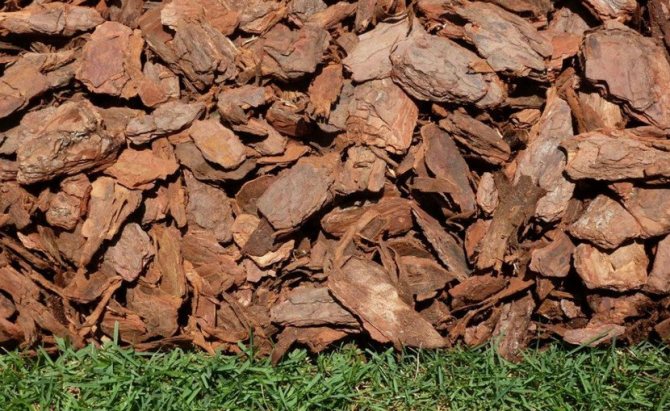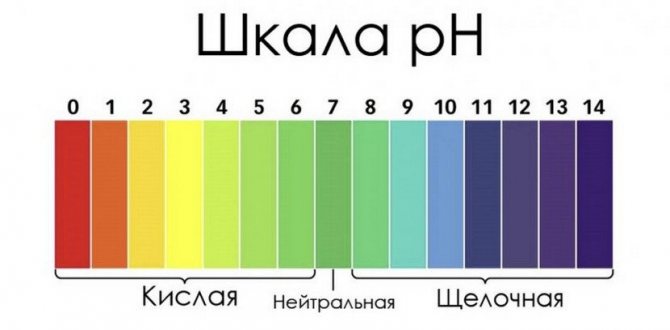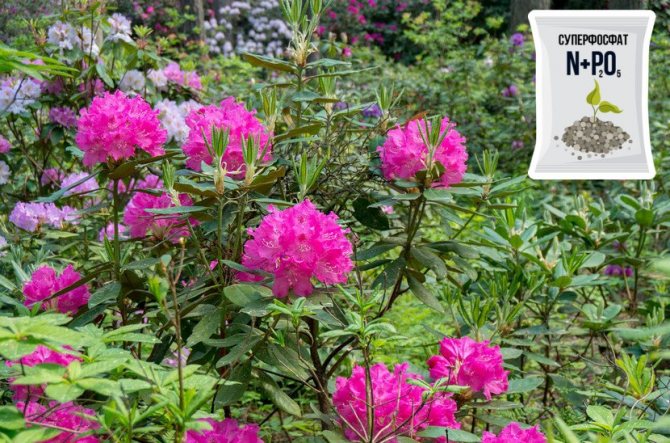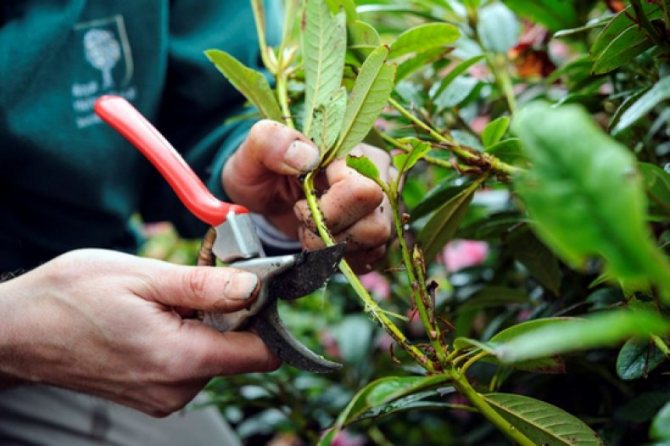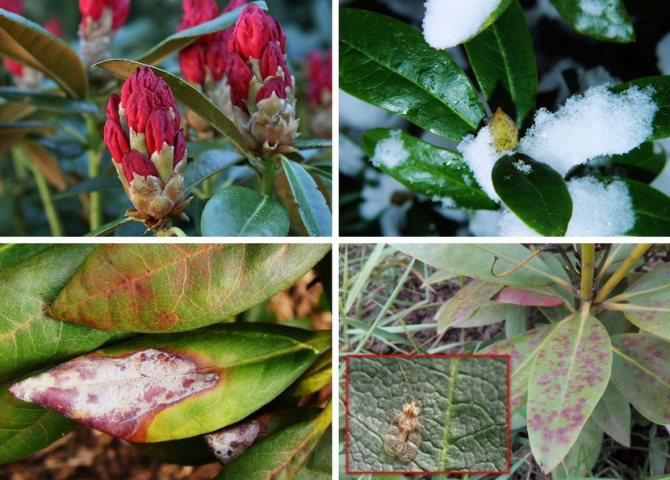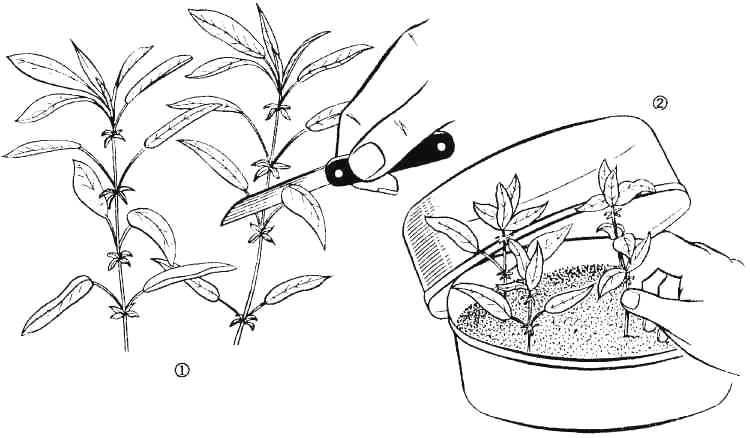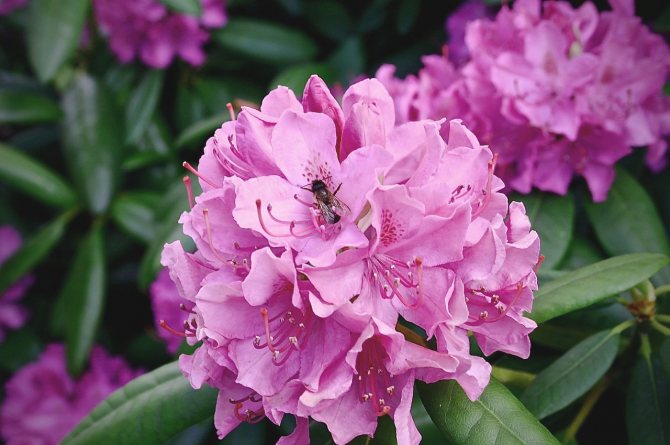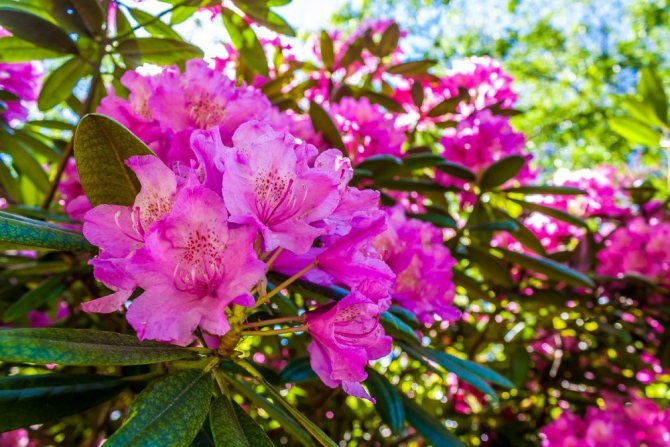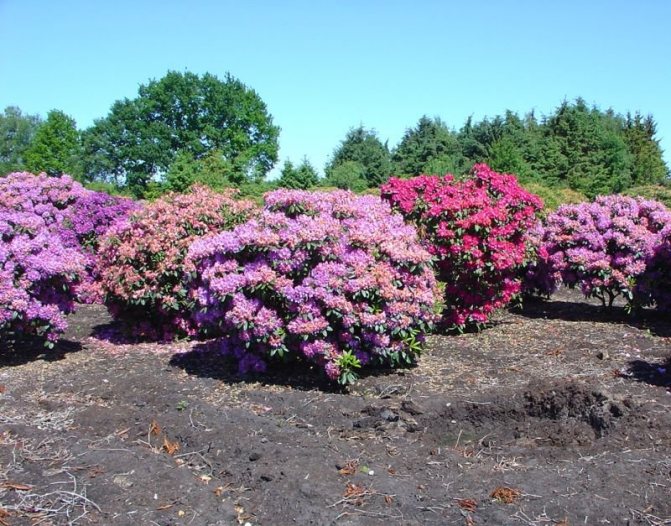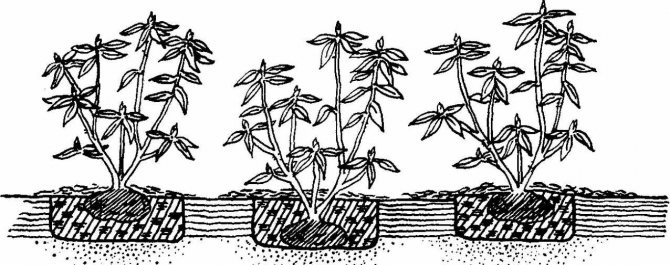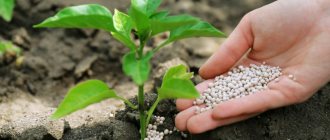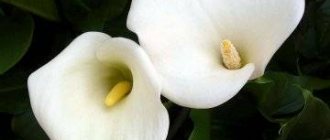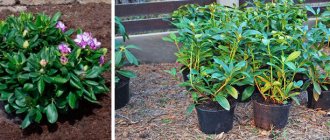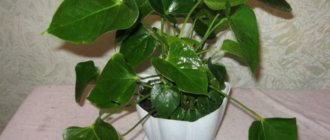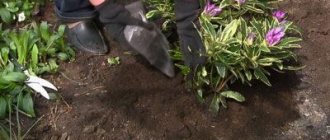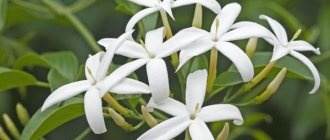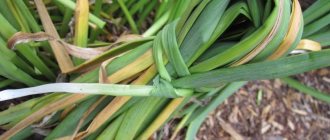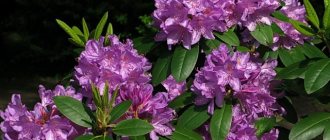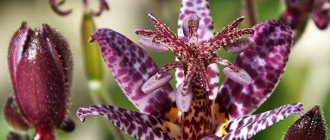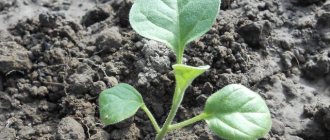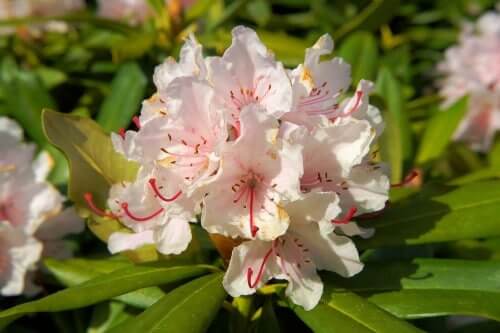
Having planted a rhododendron in a sunny place, you can wait for flowering for several years. This is because this shrub needs shading. In the scorching sun, rhododendron does not grow: the leaves get burned and dry out quickly. Rhododendron at a young age most often dies from heat.
Rhododendron plant ONLY in the shade... He is not afraid of transplants, so as soon as you notice that a rhododendron seedling suffers from the sun, immediately transplant it into a thick shade. Bushes grow rapidly and bloom luxuriantly exclusively on acidic soils with good air exchange. As a filling of the landing pit unsuitable manure, sawdust, black soil. By the way, the same picky blueberry in terms of soil is tall.
Their root system is superficial and compact, so the weeds need to be pulled out, not weeded. The roots are too close to the surfaceso they can be easily damaged. There should always be a thick layer of mulch under the bush. Then the weeds will not grow, and the soil moisture remains.
With good care and proper placement on the site, rhododendron pleases with flowering every year. Withered inflorescences must be removedpreventing the formation of seeds. In place of one removed inflorescence, 2-3 new flowers will form. The bush becomes more lush, and the flowering is more abundant and longer.
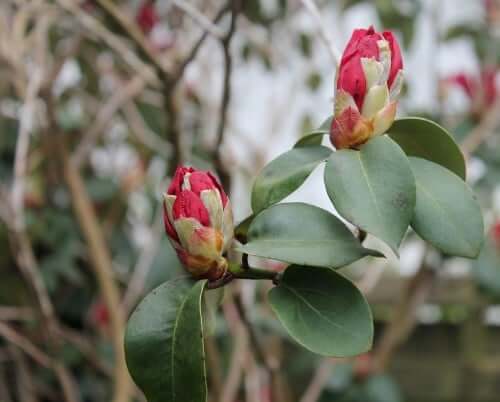

Rhododendrons are regularly watered during flowering, preventing the soil from drying out. And in the summer heat after sunset, it is recommended to spray the crown with soft water. With a lack of water, the leaves lose their brightness and turgor.
Sanitary pruning of rhododendrons
Performed according to the results of wintering in early spring. We remove the broken branches, carefully cutting out the shoot below the break. Small breaks can be tightened with an elastic bandage, secured in place, and a support can be placed under the broken branch to neutralize its weight. If the branch breaks less than half the thickness, chances are good that the break will heal. We leave the support under the shoot for a couple of years.
We cut out the frozen shoots to healthy tissue. In deciduous rhododendrons, the bark often cracks during winters with sudden temperature changes. We cut out such shoots to a living. Sometimes it is difficult to distinguish a frozen shoot of an evergreen rhododendron from a living one.
the stem, which suffered ("burned", but in fact dried up under the influence of the early spring sun and wind) only the leaves. When in doubt, postpone pruning for a while. Soon it will be absolutely clear whether the escape is alive or not. The leaves of the frozen shoot are dry, dull, and fall off easily. "Burnt" leaves on a living branch do not crumble themselves; at the base of their petioles, buds can already be seen, from which new leaves will bloom. So, in photo 2, only a few shoots in the upper left part of the crown of the rhododendron have completely lost, the rest will successfully overgrow.
Small-leaved evergreen rhododendrons are distinguished by the fact that even a shoot that has completely lost its "burnt" leaves can again be completely dressed in foliage. You should not rush and cut varieties from this group, unless the affected plant sits in full view and does not spoil everyone's mood with its condition.
Half of the success is the right fit
It is extremely difficult for a non-professional gardener to grow a rhododendron from seeds.The optimal planting is from already grown seedlings, which are purchased in the nursery. Many are sure that it is better to purchase in those nurseries that have a long-term and proven reputation. They grow up there in compliance with the necessary rules and in good faith. It is recommended to buy trees 2-4 years old, but the older the plant, the more difficult it is for it to adapt to a new place. The planting material must be carefully examined. The leaves and roots must be healthy, and the closer the branches are located along the trunk to the root system, the more chances that the future pearl of the garden will take root in a new place.
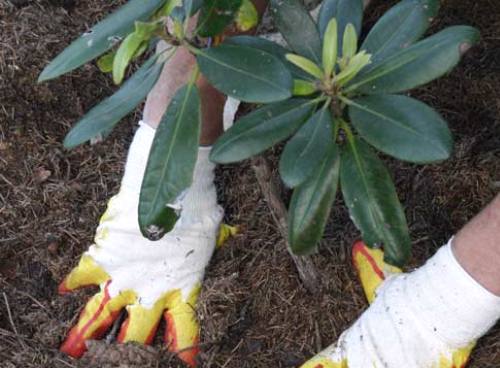

Correct fit is carried out under certain conditions:
- 1The hole for the rhizome must be prepared in advance, and the filler, nutrients, substrate, which will cover the roots, must be prepared taking into account the specific variety.
- 2The root system is buried shallowly, the topsoil is no more than 5 cm, a cover substrate is required. A roller of mulch is made around the planting site, which protects the soil from the soil quickly drying out.
- 3After planting, the plant requires careful watering. The amount of water required is calculated from the ratio of growth to liters. If the height is 40 cm, then water is needed 4-5 liters, if the meter is 10-11. In a seedling purchased with flower ovaries, a part of the ovary is certainly cut off so that the plant is guaranteed to take root.
- 4 How much and what kind of fertilizers should be applied is decided when taking into account the variety of the acquired plant, its state after planting, the time required for survival, the appearance of the rhododendron, which informs about the need for something by the state of the leaves, stem, color, cell turgor.
You should not especially try to acquire an already flowering plant. If the landing is done correctly, this is already half the way to future beauty. But a flowering plant is less likely to survive the move, because it has already spent part of its vitality on the formation of buds.
Starting pruning of rhododendrons
As a rule, we buy evergreen rhododendrons in the form of a bush with a beautiful, evenly developed, harmonious crown. Deciduous rhododendron varieties (deciduous azaleas) often do not look so good. They have one or not
how many long, naked and relatively thick shoots with inflorescences at the top and several short and thin branches. It is better to cut off such specimens immediately, trying to give the crown a more or less symmetrical shape. Already in the middle of summer, the bush will be much more branched, and in autumn you will see that a well-rooted rhododendron has quite successfully laid flower buds over the entire surface of the crown. Thus, we lose in the height of the bush, but we win in its shape and quality of future flowering. And such a bush will quickly gain height.
Formative pruning and pinching of rhododendrons
This type of pruning is done either in early spring or closer to the time of flowering of the rhododendron, i.e. outside the stage of active sap flow. We cut off poorly located branches, shorten those that weakly or do not give lateral shoots at all, i.e. naked. As a rule, formative pruning is easily accomplished on bushes of deciduous rhododendrons. Many semi-evergreens (eg Ledebour's rhododendron and the entire PJM series) respond well to pruning, responding with dense branching and a compact crown shape. With evergreen rhododendrons, it is easy to reduce or narrow the crown by cutting into a well-located branch.
A convenient technique is pinching the shoots of deciduous rhododendrons. Thus, we shorten a shoot that is too long and encourage it to branch, achieving a beautiful, evenly developed crown shape. The lateral shoots that appear as a result of the pinching have time to lay flower buds.
Description of the plant
In nature, rhododendrons are distributed mainly in the Northern Hemisphere - in southern China, Japan, the Himalayas, North America and Southeast Asia.Most often they are found in the coastal zone of rivers, seas and oceans, in partial shade undergrowth and on the northern slopes of the mountains.
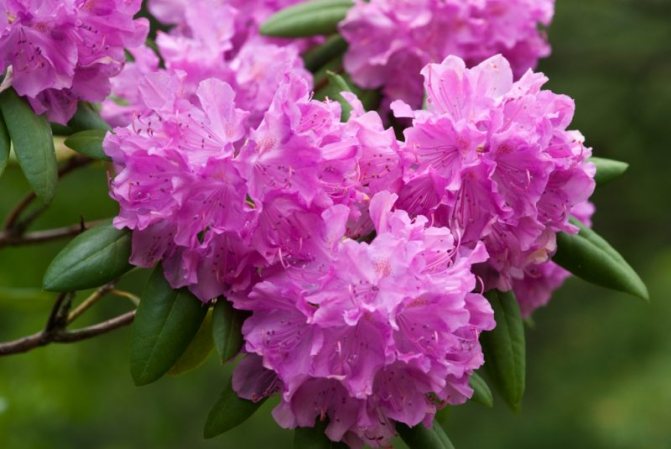

The culture refers to flowering deciduous or evergreen shrubs of the heather family. The branches of the plant can have smooth bark or pubescence.
Leathery, dark green small ovoid leaves are sometimes pubescent. Bell-shaped flowers, funnel-shaped, simple and double. The color of the petals varies depending on the variety: white, pink, lilac, red, purple.
Modern varieties of rhododendron are yellow and orange in color. Numerous small seeds ripen in capsules.
The root system of rhododendron is compact, superficial, consisting of many fibrous roots. Rhododendron is an excellent early spring honey plant.
Anti-aging pruning of rhododendrons
Anti-aging pruning, like any other pruning, works well on young rhododendrons. After radical pruning, they grow back easily. Another thing is that young people do not need it. If you are a determined person, then do not be afraid to cut the old bush into a stump, i.e. shorten all shoots to 20-30 cm. Terms for rejuvenating pruning are the same - early spring or immediately after flowering. But not all old specimens will easily tolerate such pruning.
An alternative to planting a bush on a stump with bare trunks from below, rare branching, weak flowering and other signs of aging is to replace it. Yes, sometimes it is more rational to replace a bush that has lost its decorative effect than to get it to return beauty by pruning. This is especially true for tall varieties of evergreen rhododendrons.
Evergreen rhododendrons with thicker branching and cushion growth are more likely to be rejuvenated by pruning. It is carried out gradually, shortening to 15-20 cm in several shoots per season. If successful, buds wake up on the old wood and strong young shoots appear.
Deciduous rhododendrons can usually be rejuvenated by pruning. At the same time, a radical landing on a stump is rarely required; often it is enough to simply reduce the crown by a third or half. In the photo 10 is a Japanese rhododendron bush, which is more than 35 years old.
It can be seen that the middle of the bush is bare, moreover, it has gone over in diameter, and the shoots are laid on the path. Spring pruning resulted in the result in photo 11: the crown is now thick and even. Several too long shoots in the middle of the bush will still be shortened next season.
Cut with a sharp pruner, cleanly, without squeezing. The place on the stem where the kidney will wake up can only be found with some practice. But the road will be mastered by the one walking! So we cut without fear. All sections that are thicker than a pencil are covered with varnish-balsam. After pruning, we feed the rhododendron, water it regularly, soaking the soil to the depth of the roots.
Reference by topic: Rhododendron - cultivation and species
Growing a garden shrub
The plant can be propagated by laborious seed, as well as vegetatively - by cuttings and layering (for details on how to reproduce azaleas at home, read here).
Seed propagation
The sowing substrate consists of equal amounts of peat and sand. In spring, small rhododendron seeds are scattered over its moist surface and covered with plastic wrap. The greenhouse is kept at 20 degrees, the substrate is ventilated and moistened. The germination time is usually 3-4 weeks.
When the first true leaves grow seedlings are planted more freely, while deepening them to the cotyledonsto stimulate root development.
After that, young plants are kept at a temperature of 8 to 12 degrees and a daylight hours from 16 to 18 hours, which is created by additional lighting. Water through the pallet.
By June, the seedlings are again planted less frequently and grown.
Winter temperatures should not rise above 18 degrees. In the spring, small rhododendrons are again planted at a distance of 3-4 cm from each other, but only in the third year will they be ready for planting in the ground.
Cuttings
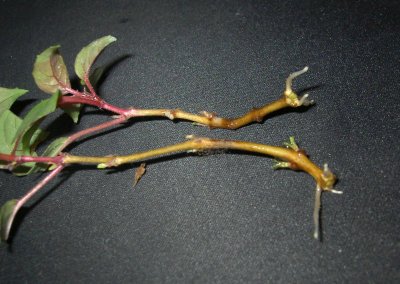

For this method of reproduction, semi-lignified shoots are used, from which 5-8 cm cuttings are cut. The lower sections are placed in a growth stimulant solution for 12-16 hours. Then they are planted in containers with a light soil mixture and covered with plastic wrap.
Ventilate, maintain humidity. Rooting takes a long time (up to 3 months) and is not always successful. Rooted cuttings are grown in a mixture of peat and pine needles; They hibernate indoors, at a temperature of about 10 degrees. In the spring, they are buried in the ground in planting boxes, and finally planted, at least another year later.
Layers
In the spring, the selected young branch is bent to the ground, fixed, added dropwise and watered, avoiding stagnant moisture (with what water and how should the azalea be watered?). When new resistant shoots appear, the layers are finally separated.
Pruning rhododendron - photo to article
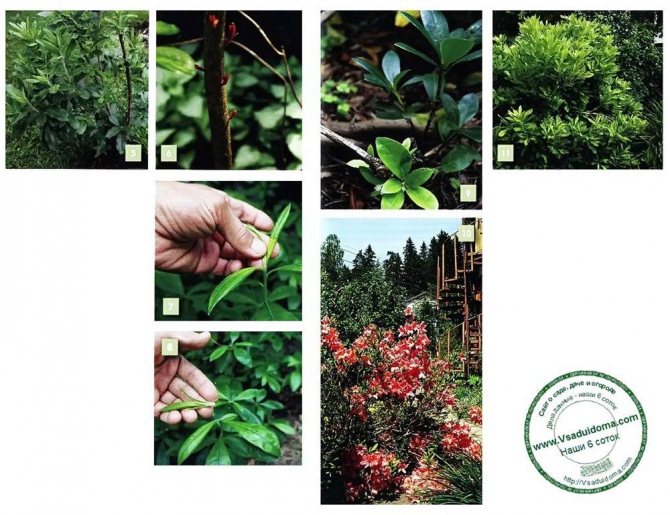

ORDER QUALITY AND CHEAP SEEDS AND OTHER GOODS FOR HOME AND COTTAGE. PRICES ARE BOTTLE. CHECKED! JUST SEE YOURSELF AND BE AMAZED. THERE ARE REVIEWS. GO >>>
Below are other entries on the topic "Cottage and garden - do it yourself"
- Rhododendron - cultivation and species: Planting and caring for rhododendron For ...
- Pruning raspberries and currants - master class: Regular pruning of currants and raspberries More ...
- Pruning roses for winter - just about the difficult: Autumn pruning of roses ...
- Spring pruning of roses - how is it right ?: Pruning roses in spring Spring pruning for ...
- Wintering of rhododendrons - shelters, mulching and watering: FOR RHODODENDRONS TO PASS THE WINTER [caption id = "attachment_33080 ″ ...
- Rhododendron at home - planting and care: Rhododendron in a pot - planting ...
- Trimming gooseberries and currants in October (Leningrad region): Trimming currants and gooseberries in ...
Subscribe to updates in our groups and share.

